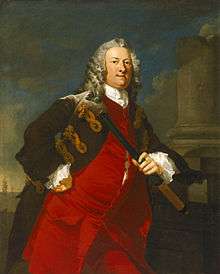Thomas Smith (Royal Navy officer)
| Thomas Smith | |
|---|---|
 Portrait by Richard Wilson | |
| Born | 1707 |
| Died | 28 August 1762 (aged 54–55) |
| Allegiance |
|
| Service/branch |
|
| Rank | Admiral |
Thomas Smith (1707 - 28 August 1762)[1] was a British admiral and colonial governor, credited with the invention of the divisional system that remains in use on ships of the Royal Navy.[1]
Early life
Born in England around 1707, Smith was the illegitimate son of Sir Thomas Lyttelton[1] and a woman of whom details are unknown. He was raised a member of the Lyttelton family, who provided for Smith's education and aided him in the beginnings of his career in the Royal Navy.[1]
Early naval career
The precise date as to when Smith entered the Royal Navy is unknown, but his first notable appointment in the Service was to the position of junior lieutenant aboard the Royal Oak on 6 February 1728, at the appointment of his commanding officer Sir Charles Wager. In June of the same year he was moved to the 44-gun Gosport under the command of Captain Duncombe Drake.
While a lieutenant aboard the Gosport, Smith attracted great controversy in an incident involving a French corvette in late November, 1728. At the time of the incident the Gosport was harboured in Plymouth Sound and Smith was acting-commanding officer due to all of his superiors being ashore. While in command, a French corvette that had entered the Sound for shelter passed the Gosport while departing, and Smith signalled for the French captain ‘to haul in his pennant in respect to the king of Great Britain's colours’.[1] Having already saluted the Royal Citadel of Plymouth, the French captain took this as an affront and the French authorities, upon receiving his report, presented an official letter of complaint to the British government. Smith was thus court-martialed and summarily dismissed from the Navy by king's order on 27 March 1729.[1] However, due to popular outcry at his dismissal,[1] he was reinstated at the same rank and made second lieutenant of the Enterprise on 12 May of the same year,[1] receiving the nickname 'Tom o'Ten Thousand' from his fellow seamen.[2]
On 5 May 1730, Smith was promoted to the rank of captain and given the command of the 24-gun Success.[1] Two years after this Smith was given command of the Dursley Galley,[1] a 20-gun fast frigate stationed in the Mediterranean, mainly tasked with patrolling against Barbary Pirates.[1] Remaining mainly in the Mediterranean, Smith remained in this position for a decade.[1]
Tenures as Governor of Newfoundland
In 1740 Smith transferred to the 50-gun Romney, on board which he sailed back to Great Britain. Smith then departed aboard the Romney with the fishing fleet to Newfoundland, where he was to become governor. He only held this position for one year, resigning in April 1742,[1] but was appointed again as governor and commander-in-chief in 1743 after a brief return to the Mediterranean.[1]
Late naval career and the creation of the divisional system
Smith left the post of governor for good and was placed in command of the 100-gun Royal Sovereign in September 1745.[1] Around this time Smith spent a lot of time organising anti-invasion defences off the coast of Suffolk and Essex aboard the 40-gun Hastings.[1] In February 1746 he replaced John Byng as commander-in-chief on the Scottish coast, a position he stayed in until January 1747.[1] Smith was promoted to Vice-Admiral in 1748,[1] and in August 1755 he was made commander-in-chief of the Downs Squadron.[1]
Soon after taking command of the Downs Squadron in 1755, Smith began to draft a scheme to combat the problems regarding relations between the officers and the men in the Royal Navy.[3] Under this system the lieutenants on board a ship would be placed in charge of a division of the ship's company, and would be responsible for the health, welfare and efficiency of the men under their jurisdiction.[3] This system became known as the divisional system. While originally confined to Smith's Downs Squadron, it soon spread to other ships in the Service and was widely, though not universally, admired by the end of the Seven Years' War.[4] By 1765 the system appears to have been the structure of choice for ships in the Royal Navy.[4] A very efficient arrangement, Smith's divisional system resulted in increased efficiency and closer control, as well as improved communications between the officers and men on board.[4]
In December 1756 he was ordered back from the Downs to preside over the trial of Admiral John Byng, at which Smith apparently did his utmost (albeit unsuccessfully) to see that the court's recommendation of leniency was followed.[4] Smith then returned to the Downs Squadron on 24 February 1757 after promotion to the rank of Admiral of the Blue, but ill health forced Smith to declare his retirement the following year.
Death
Thomas Smith died at his Rockingham Hall residence on 28 August 1762.[1]
Citations
- 1 2 3 4 5 6 7 8 9 10 11 12 13 14 15 16 17 18 19 20 Daniel A. Baugh (September 2004). "'Smith, Thomas (1707?–1762)'". Oxford Dictionary of National Biography. Oxford University Press. Retrieved 23 November 2008.
- ↑ "Adm. Thomas Smith Papers". Retrieved 23 November 2008.
- 1 2 Rodger, N. A. M. (March 1988). The Wooden World: An Anatomy of the Georgian Navy. Fontana Press. p. 217. ISBN 978-0-00-686152-2.
- 1 2 3 4 Rodger, N.A.M. The Wooden World. p. 218.
See also
External links
- Biography at Government House The Governorship of Newfoundland and Labrador
- Works by or about Thomas Smith in libraries (WorldCat catalog)
| Political offices | ||
|---|---|---|
| Preceded by Henry Medley |
Commodore Governor of Newfoundland First Term 1741 — 1741 |
Succeeded by John Byng |
| Preceded by John Byng |
Commodore Governor of Newfoundland Second Term 1743 — 1743 |
Succeeded by Charles Hardy |